Silpoha is conducted in the early morning of the day of the marriage in a fasting mode , by the Mother of the groom , supervised and accompanied by her mother-in-law or 'jethani'(husbnd's elder brother's wife).She should be a 'suhagan' and not a widow.They are accompanied by the other elderly ladies of the family for this ritual.The groom's mother (in her chunri attire with nath-teeka and all) along with her mother-in-law perform this puja under the cover of the chunri, grinding 'akshat'(rice) on sil (flat grinding stone) with a rolling pin.
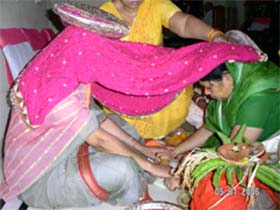 As they grind, they give a call to the Gods and the spirits of the ancestors and ask them to protect their family from all natural (jal,vayu.agni,dhool-mitti etc.) and unnatural calamities.And to bless them to go through this(marriage)yagya without any 'vighna-badha'(obstructions) , to protect their families today and always.They offer their abeyance and seek their 'kshama' and guidance.
As they grind, they give a call to the Gods and the spirits of the ancestors and ask them to protect their family from all natural (jal,vayu.agni,dhool-mitti etc.) and unnatural calamities.And to bless them to go through this(marriage)yagya without any 'vighna-badha'(obstructions) , to protect their families today and always.They offer their abeyance and seek their 'kshama' and guidance. rasm # 2
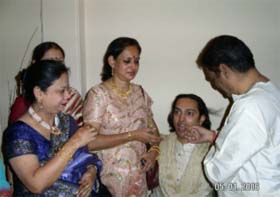 Imli -Ghutai is performed by the groom's (mama-mami) maternal uncle and aunt on the groom just before the 'paricchavan'.This is done to ward away the bad omens and to tell the groom to keep away from all vices. Even if the closest and dearest person around coaxes him to indulge in any vices, he must have the courage to resist it. The mama feeds a beetel leaf to the groom, but the groom just holds it with his teeth and the mother of the groom takes it away from his mouth and eats it herself, signifying that the mother shall take away all the bad omens falling on her son upon herself.
Imli -Ghutai is performed by the groom's (mama-mami) maternal uncle and aunt on the groom just before the 'paricchavan'.This is done to ward away the bad omens and to tell the groom to keep away from all vices. Even if the closest and dearest person around coaxes him to indulge in any vices, he must have the courage to resist it. The mama feeds a beetel leaf to the groom, but the groom just holds it with his teeth and the mother of the groom takes it away from his mouth and eats it herself, signifying that the mother shall take away all the bad omens falling on her son upon herself. 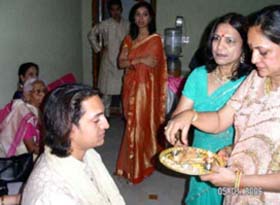 The mama- mami give clothes to the family of the groom as blessings on this occassion.
The mama- mami give clothes to the family of the groom as blessings on this occassion. rasm # 3
Paricchavan' is performed by the mother of the groom on the groom just before the departure of the baraat (marriage entourage). She does the aarti of the groom to ward away all bad omens and puts on the 'tilak' on his forehead with her blessings for a new auspicious beginning.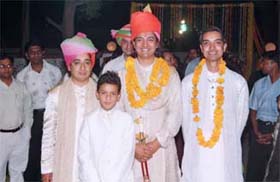 Baraat Prasthan is (departure of the entourage)for the venue of the wedding, usually to the bride's place. But since, now-a days people have small flats, a commercial venue is hired for the occasion). The groom's car is decked up with flowers and fringes. He is accompanied in the car with 'sahwala' (best man), which is usually his youngest brother.Sehwala is appointed with the view that, in case of any mishappening, it shall be he who shall take care of his brother's wife and family and as such, the sahwala is as pampered as the groom at the bride's house.
Baraat Prasthan is (departure of the entourage)for the venue of the wedding, usually to the bride's place. But since, now-a days people have small flats, a commercial venue is hired for the occasion). The groom's car is decked up with flowers and fringes. He is accompanied in the car with 'sahwala' (best man), which is usually his youngest brother.Sehwala is appointed with the view that, in case of any mishappening, it shall be he who shall take care of his brother's wife and family and as such, the sahwala is as pampered as the groom at the bride's house. 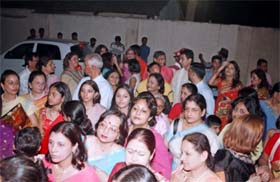 The groom's car is led to the venue of the wedding with bands playing filmy 'dhuns' and 'laundas'(eunuchs) dancing the way. Youngsters of the family also join the dancing.Now-a-days all the family members , those who wish, join in the dancing.The eunuchs are blessed with 'bakshish' and given 'vidai'.
The groom's car is led to the venue of the wedding with bands playing filmy 'dhuns' and 'laundas'(eunuchs) dancing the way. Youngsters of the family also join the dancing.Now-a-days all the family members , those who wish, join in the dancing.The eunuchs are blessed with 'bakshish' and given 'vidai'. It is very easy to see a bihari baraat entourage consisting of 300-500 members, if local. If outstation, then it may vary from 50-150 consisting of ladies, gents and children.
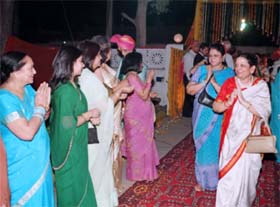 Biharis , generally are quite liberal yet traditional. They do not carry any attitude nor are they inhibited by anybody else's attitude. They are quite free of any artificial pomp and show and in a way have a rustic touch of their roots, which they are very proud of.
Biharis , generally are quite liberal yet traditional. They do not carry any attitude nor are they inhibited by anybody else's attitude. They are quite free of any artificial pomp and show and in a way have a rustic touch of their roots, which they are very proud of.
No comments:
Post a Comment